Everyone manages the maintenance and cleaning of their aquarium differently, but I thought it would be helpful to go over the basics of maintaining our Freshwater Fluval Spec V. This should apply to the smaller Spec III as well.
The timeframes are a rough estimate. Life gets in the way and occasionally tasks are neglected a day or four, but this is the rough idea.
Daily Maintenance:
- Feed the fish / shrimp / inverts
- Dose Seachem Excel
The biggest daily task is to simply take a bit of time and observe the aquarium. So much is understood about your tank by being able to perceive small changes over time and the only way to do this is to look inside you aquarium often to notice what is happening.
It’s a bit hard for the fish to get the food that I put in with the pump flowing, so I unplug the pump right before I feed, and hopefully remember to plug it back in after they are done eating.
Twice a Week Maintenance:
- Clean the inside of the glass with my Mag-Float.
- Clean smudges, fingerprints, and water spots off the outside of the glass with a microfiber cloth.
- Add water to fill (if necessary)
I get just a bit of algae buld-up on the glass and mid-week is a great time to give it a 2 minute scrub with the Mag-Float.
Myself and the kids (mostly the kids) get the glass smudged up. I just clean it with a small microfiber cloth. Water only – wet part of the cloth to help remove the spots and then dry with the other part. I choose to never use any cleaner on the outside; certainly not anything like Windex. Spraying cleaner near your aquarium will contaminate your water and can potentially kill your fish.
If I need to add fill water because the water level is low, I add tap water to a clean (aquarium only) tupperware and then add a dose of water conditioner for that volume. My container is small enough that two drops of conditioner is more than enough. I then move the light and pour water straight into the top opening. This is sometimes challenging and you may have more luck setting the top aside. Note that if you fill it up very high, the water will touch the acrylic top when you replace it; I don’t see any problem with this.
Weekly Maintenance:
- Clean Water spots off inside of cover
- Clean algae from inside of glass
- Clean hard water deposit from water line
- Trim Plants
- Evict extra pond snails
- Perform Water Change
- Fill water to capacity
- Dose fertilizer
My weekly maintenance is the cornerstone of keeping the tank healthy and clean. I start out by getting out the bucket that holds my aquarium supplies and laying out some towels.
I set the light aside, take off the acrylic top, and spend 20 seconds wiping the water off the inside of the Fluval Spec lid with a soft towel.
Next, I use a small tupperware to dip out some water. I want to remove enough to be able to get my arms into the tank and not displace water over the edge.
I leave some water in this tupperware and set it next to the aquarium. I then trim any dead leaves and put the clippings into this container. I also spend some time removing excess pond snails and put them in the debris container as well.
Then, I take a toothbrush (used only for the aquarium) and scrub algae down near the substrate and in areas where driftwood is tight to the glass and the Mag-Float can’t reach. I also scrub up at the water line to take off some of the hard water deposits. The last job with the toothbrush is to stir up piles of detris that collect in certain spots around the aquarium and get the junk floating up in the water. [Edit: I now use an algae scraper instead of the toothbrush and/or Mag-Float for weekly glass cleaning.]
After that, I hook up my DIY Python (type) water changer to the kitchen faucet and set the valve to suck water out. I usually perform a 50% water change, but something closer to 30% is also common. Before I start removing water with the water changer, I unplug the pump since the water level will drop below the overflow. I then turn on the water and use my DIY PVC attachment and suck out water till the level in the main tank is at half, paying attention to suck out detritus on the substrate and large floating debris. When I remove the desired amount of water, I turn off the water faucet and switch the valve to the fill position. Luckily, since the Fluval Spec line of aquariums are small nano tanks, this step doesn’t take long at all.
At this point I prepare to refill the tank. I drop in a digital thermometer to monitor the tank water temperature as I fill.
Then (very important to not forget this) I add a dose of water conditioner to remove chlorine. My product of choice for this is Seachem Prime (see my handy Seachem Prime Dosing Calculator). Since I am adding the tap water directly to the aquarium, I add a dose suitable to treat the full volume of the aquarium (about 5 gallons for my Spec V).
EDIT: I need to add a step here. After siphoning water out of the tank, it is a good idea to take your hose end back to the sink and flush clean water through the hose. If you don’t, you will pump some of the dirty water back into your tank.
For refilling, I first make note of the current temperature of the aquarium water. I then turn the facet – during the winter it is mostly cold but with a bit of hot water added in. In the summer here in Texas, I don’t bother checking the temperature with the thermometer – I just add all cold water as I can’t get it any colder than around 80 degreed F. I add water slowly while pointing the water flow at the glass, being careful not to disturb the plants or substrate too much.
Don’t be discouraged if, after all the hard work of a water change, your aquarium looks worse. All the water movement tends to stir up significant debris that you won’t be able to catch in a partial water change. Rest easy, everything will settle down. The day after a water change your aquarium will look its best.
Every Month:
- Clean filter media.
I do this at the same time that I perform a weekly water change, but with a few extra measures to get the filter media clean(er).
Before I vacuum water out of the main tank, I first transfer some aquarium water (important, not tap water) into a container suitable for cleaning the sponge filter media. I found a 1 gallon tupperware that is tall with a small base that perfectly contains the filter sponge.
EDIT: I have found it difficult to transfer enough aquarium water to adequately clean the media so I have started using tap water with a few drops of Seachem Prime to make it safe.
I then pull the filter media (with the biomax rings, Purigen, etc.) and plop it all in this container. I give it a bit of a squeeze to dislodge as much detritus as possible. I take the biomax ring and Purigen bags out of their respective holes in the filter sponge and swish them around in the water. For now, I just leave all of this in that container.
I then prepare to vacuum out the aquarium, but instead of vacuuming out the main display tank, I first start with the filter section. I lower the end of my DIY PVC vacuum down to touch the bottom of the filter section and start removing water. This gets much of the detris stirred up and out of the filter and pump sections.
Because I have plugged the bypass in my Spec, no water transfers over to the filter section. I can then perform my 50% water change.
Before filling back with water, I lift the sponge filter out of the washing container, put the biomax and purigen bags back in, and lower the filter media back into the aquarium filter section. Don’t become compelled to get all of the dirt out of the filter media; just try to get it cleaner, not completely clean. This is what is left over after you squeeze out and swish around your filter media:
A word of warning when dealing with the filter media. Do not rinse with untreated tap water. Chlorine in the tap water will kill the beneficial bacteria in the filter system and may stall your cycle, causing a subsequent spike in ammonia and/or nitrite. Either use old aquarium water or tap water that has been treated with a dechlorinator.
EDIT: Since I originally wrote this, I have since started to clean my filter media every time I perform a water change, which is about once a week. I started to have some water clarity problems and ended up with unhealthy fish; I attribute these problems to the filter media becoming entirely too dirty between cleanings. It really depends on your bio-load and how much waste is trapped. If you clean it out weekly but are not noticing much detris trapped in the filter, maybe you can extend the filter media clean to every other water change or every month. I encourage you to keep a careful eye on water quality and adjust the filter media cleaning frequency accordingly.



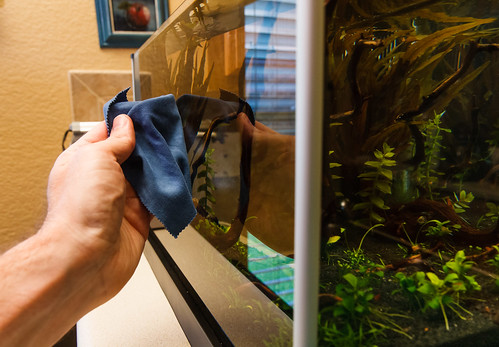

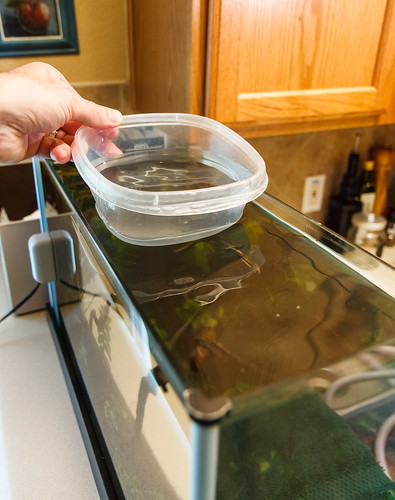

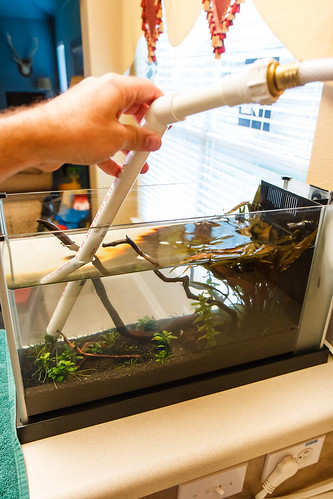



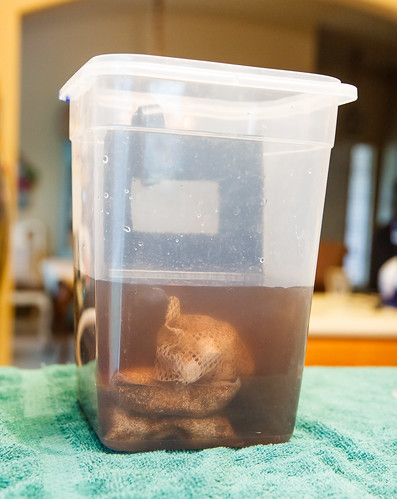
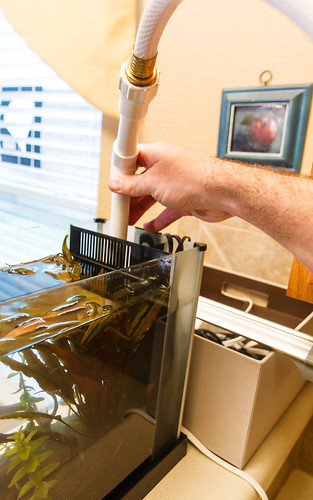
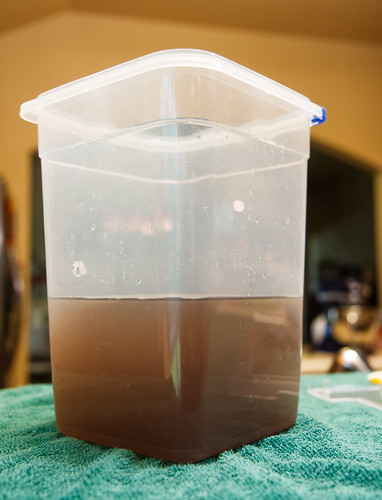

Hi:
I have a fluval spec 5 as well how ever I do have some small cichlids and I was wondering if there is a nano filter that I can used to better clean the tank. the water is always cloudy and doesnt seems to be clear. I don’t think that that equipment that comes with this tank is sufficient to keep it clean. any ideas or recommendations.
The stock filter, if maintained (regular water changes and occasional filter media rinse) should be able to maintain good water quality. If the stock filter can’t keep up, the bioload is probably too high, meaning too many fish or fish that aren’t suitable for a 5 gallon nano, or overfeeding. You might take a careful look at the livestock in your Spec and make sure they aren’t the root of the problem. A secondary filter might help, but you still may have underlying problems.
Then again I’m no expert on Cichld’s and you don’t mention the exact species. If you do find a suitable alternative filter let me know.
Hi. I have the same tank as yours and I cleaned out the back filter of the tank and there was so much debrises and waste, the color was orange brownish and the waste clogged together. I was quiet shocked while the main tank is super crystal clear and the back is brown and dirty. Is this normal? Do I clean it once a week with the water change?
Yes – I have changed to wash out the filter media every time a I perform a water change, which is once every 7 to 10 days. It will vary on how much load is in your tank (how many critters) but it sounds like weekly media wash is what you need.
I just bought the Fluval and really love it — the one question I have is that the water flow going through the slots seems like it’s not taking any water in. I put my hand inside the tank against the slots and it doesn’t feel like it’s taking anything in–perhaps the intake pressure is supposed to be really minimum? However, the water is exiting the tube at a great flow rate, but I just wanted to make sure that the water is being circulated internally, not just externally. Thanks!
Yes, what goes into the display (out of the nozzle) must go through the slots. It is just lower velocity. When you are dealing with a very dirty, stirred up tank and the water gets filled with particulate, you can readily observe the particles getting drawn into the filtration slots and system.
Do you ever replace the sponge, or just keep rinsing it out and the sponge stays usable indefinitely?
I don’t know about ‘indefinitely’ but we are going on more than 2 years and it is going strong. With some rough treatment it might tear, in which case it would be time to replace.
It does say on the manual to replace the foam block every year and the biomax every 6-8 months, but wouldn’t that disturb a massive amount of beneficial bacteria? Not sure about this.
You have beneficial bacteria on every surface of your tank: gravel, glass, plants, decorations, etc. If you want to replace your media, do it one piece at a time. Replace one component (either foam or biomax), then the other a few weeks later. There should be plenty of beneficial bacteria remaining to maintain a healthy tank. If you get an ammonia spike (test during this time), then just perform water changes more often as the tank catches up.
I actually cut the big black filter sponge in half length-wise (3 cuts down the middle) and change out half of it every (other?) time I do filter maintenance. I always remove & discard the right side, then rinse out the left side and put it back in on the right side, then put a new sponge on the left. I’ve never had a problem with ammonia spikes.
Interesting idea. I haven’t replaced my sponge filter over the life of our Spec V (over 2 years now) so there are definitely different approaches.
Article was very helpful. thanks for the info!
Hi there
I have had a fluval spec tank for past 2 year but only this week I am having difficulty with the water getting to the back chamber where the pump sits..when I take the black sponge out the water pours through to the back pump section but few minutes after replacing the sponge the water virtually dried up in the pump section and therefore pump only makes a sucking/gargling sound and little water comes out. Any suggestions? Do you think the sponge has fallen to low in the tank?
No idea. Either the sponge is very clogged or your aquarium is low on water – would be my guesses. Let me know if you find the cause.
Best of luck!
Nate,
I found every one of your articles very informative. It actually helped me decide to purchase two of these tanks. In reading this article, I noticed you stated that you unplug your filter during feeding and hope to remember to turn it back on. I hope to reach out to you and your followers for a DIY solution to this issue. I made a quick and easy 10 minute timer for feeding purposes. I have been using this on all of my tanks for the past 30+ years. Just press the button and feed.
I posted a write up on the construction of this simple project in the Planted tank Forum. I hope you can find this useful.
http://www.plantedtank.net/forums/9-equipment/1114194-0-10-minute-feeder-timer-project-15-minutes.html
Mike, that’s a great idea. Thanks! 🙂
thats a good idea
I have a new fluval Spec 5 gal and it has been all set up for over a month & I have one Betta in it and 1 large snail and two tinny ones – it was crystal clear for about 4 weeks and even when I did a water change but then I did a water change for third time and noticed that the water became very cloudy and dirty looking so I had to empty the whole tank and start from scratch – what went wrong?
After it went cloudy, how long did you give it to clear up (before you ‘started from scratch’)?
I was away for about 3 days and when I got back I took one look and it was awful so I immediately took out half the water and then took out the Betta and decorations and plant
etc. cleaned all the sand and kept flushing the water out until the sand came clean – I then
refilled the tank with fresh water and decorations let it warm up to 80 degrees put Casper
(betta) back in and it is as clear as a bell now and hopefully I don’t have to do that again
The pet store told me it probably was an algae bloom maybe because of the water change I did before I went away – other than all this I just love the tank – the tank didn’t clear up on it’s own
This probably sounds like a dumb question but is it OK to use a used Tupperware to clean the sponge? All of mine have been through the dishwasher. Do I need to buy a new, never-washed container? Or is it OK to use dishwasher washed items for fishkeeping?
I think it would be fine to use ‘used’ tupperware – just make sure to rinse it with plain water very well. I personally splurged and spent the $3 or so on a tupperware set that I could use specific to the aquarium – marked it as such with a sharpie so it wouldn’t get mixed in with the kitchen stuff.
Does the pump on the Spec V come apart for cleaning? I’ve had to coax it to restart after the last few water changes and feel if I could only take it apart to clean the impeller the problem would be solved. I don’t want to force it unless I have a replacement on hand in case it breaks.
I don’t know that the pump comes apart. It possibly is clogged with dirt or a piece of sand that is blocking the impeller. You might try flushing well under a running faucet, or even hitting it from the outside with compressed air (go easy on it if you do this).
I’ve done all that. I saw in a plantedtank forum where someone advised to take the pump apart and clean the impeller, and the response was it was successful. I then contacted Fluval and their response was that it can be taken apart by removing the grill to access the impeller. I’ll do that this weekend when I do my water change. You would think Fluval would include this important maintenance detail in their instructions. I discovered that many people replace the pump when it stops.
Hello! Like others, awesome site! Question: we have well water tested by Petco as great for fish. Can I assume I don’t need the anti-clorine dose?
Thanks in advance! … Jon
If there is no chlorine in your well water, then yes – I’d say you can skip the dechlorinator.
I also have the Fluval Spec V with NO fish just 2 Mystery snails & I do a 30 – 50% water change weekly & it doesn’t seem to be frequent enough. My substrate is Spectrastone, its has live plants & a heater Everything else is as it came with the set up I altered nothing. It ALWAYS seems DIRTY ! I always gravel vac w/each pwc and usually rinse the filter & media in the removed aquarium water before replacing it. I’m not about to put a fish in this tank until it stays clean. Water parameters are all within normal limits per API Master freshwater parameters (I don’t trust them)! I’ve already lost one betta & am not about to risk another one getting ill. This Fluval Spec was bought to be a Hospital tank for my beloved betta that passed. I have not been impressed with this tank AT ALL! I also have had a TERRIBLE pest snail infestation & some WEIRD white worms on the glass. My snails seem to be doing ok though which is good.
Would any of you suggest keeping this tank & eventually putting a solitary betta in it?
Our tank water quality is good, but it does better with some helping filter media additions.
If the ammonia and nitrite are both zero and nitrates are reasonable, and you maintain consistent temperature, then I don’t see a reason not to put a fish in there.
One thing you don’t mention is pump maintenance. The cover of the pump can be removed and the impeller chamber and impeller cleaned. I like to do this every couple of months. Awesome site!
I’ve never done this (removed the pump cover for a thorough cleaning). I’m satisfied with rinsing it every year. Good to know!
I am new to having a fish. I have the Spectra and a Betta inside. I have been trying to follow all the directions to set up tank, keep my Betta healthy but every time I do a partial water change I end up with green and white “things” floating all over my tank. It seemed like my tank was way cleaner when I had a little one gallon tank and no filter. I don’t know what I am doing wrong.
If it’s brand new, it could be a biological ‘bloom’ (speaking of white or cloudiness). The aquarium hobby sometimes requires patience. Give it time to see if it sorts itself out. Make sure to regularly clean the sponge filter media. Consider adding additional filter media as this has done wonders for water clarity in our freshwater Spec V.
Thank you for all your posts that are extremely helpful and informative! This may be a dumb question because you don’t call it out above, but do you remove the fish from the tank for the water change? Thank you!
Not a dumb question. It’s a little disconcerting, but yes – leave all the critters (fish, shrimp, snails) in the tank when you perform a water change. This is why it’s important to match the water temperature (what you add compared to what is in the tank) as best you can (a few degrees at most) so you don’t shock them. If you do this, and add dechlorinator, they will be fine.